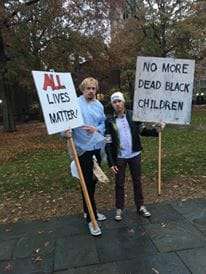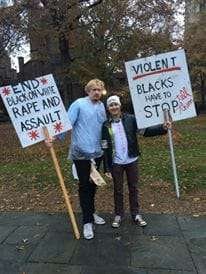The Volokh Conspiracy
Mostly law professors | Sometimes contrarian | Often libertarian | Always independent
Yale, speech, white-on-black violence, black-on-white violence, and black-on-black violence
1. Earlier this week, two signs were spotted at Yale. The front sides said "All Lives Matter" and "No More Dead Black Children." But the backs appear to have said "End black-on-white rape and assault" and "Violent blacks have to stop[;] tell them." I got the back-of-the-sign text from the "comedy" group ("Million Dollar Extreme") that is reported to have been displaying the signs, and I'm not sure about their credibility. But they did send photographs:


And the photographs are consistent with the account in the Yale Daily News (David Shimer & Victor Wang), which discussed the text on the backs of the signs but didn't quote it. (I e-mailed the Yale Police Department and the authors of the Yale Daily News article to see if they could give me the sign text, but haven't heard back from them. I also e-mailed Million Dollar Extreme's account of the sign text to Afro-American Cultural Center Director Risë Nelson Burrow - one of the people who is said to have seen the signs - to ask if it was accurate, and she declined to comment.) The Million Dollar Extreme people asked me to note the following statement from them: "We found these racist-ass signs when we were down by [a local] store fucked up on xannys and percs. These hot-ass girls were laughing it was tite. We took the signs around cuz we were wanted to find whoever racist made them and make sure ppl knew what's really going on at Yale, u know? We talked to school administration and everything's cool now so it's whatever." I'm not sure what to make of this, of how credible they are, and thus of exactly what their intentions were. But for now, let's focus on the signs as they were apparently displayed, and as they were perceived by viewers, regardless of what might have been inside Million Dollar Extreme's mind.
2. According to the original Yale Daily News story, Ms. Nelson, together with a student who saw the signs, apparently filed a police complaint. (The story has since been edited to remove Ms. Nelson's name, on the grounds that the story "attributed unauthorized comments" to her, but I have no reason to doubt the original account that Ms. Nelson participated in filing the police report.) The Yale Daily News story reported that "YPD Lieutenant Brian Logan said his department's investigation of the incident is ongoing." But when I corresponded with "Million Dollar Extreme," I was told that they talked to an administrator, who told them the police wouldn't be taking any action.
3. According to the Yale Daily News article, Yale College Dean Jonathan Holloway said that "Racist messages are disgusting and cowardly …. I don't ever want to see them on our campus. We need to condemn this kind of behavior." And he issued a statement saying:
The University condemns these messages, which are an affront to us all. As President Salovey and I wrote just a short time ago, Yale embraces our community's diversity, and it is committed to increasing, supporting and respecting that diversity; it is what makes our campus such a vibrant and dynamic place, built on mutual respect.
* * *
Now a bit of analysis, always assuming that I'm right about what's on the signs.
4. To begin with, note that the signs are clearly First Amendment-protected speech. There is nothing on them that constitutes a punishable true threat of violence (and the Yale Daily News mentions nothing to suggest that there was such a true threat, other than Burrow's conclusion that the signs were "scary"). It's hard to see what there was for the police to investigate here, and what basis there was for a Yale center director to view this as an issue for the police.
There certainly are circumstances where the police can view even fully protected speech as a reason to investigate further. (A blog post saying "I hate Joe Schmoe" is protected speech, but if Joe Schmoe has just gotten killed, the police might want to talk to the blogger to see if he might be connected with the death.) But it's hard to see what those circumstances would be in this case, unless the call to the police was just along the lines of, "there are these signs here that seem abandoned, please take them in so their owner can claim them if he wants."
5. The signs certainly express racial hostility, and they are - whether or not seriously intended - street theater rather than scholarly discourse or detailed debate. But street theater is, as we've been seeing, a big part of college student political movements (and of public discourse more broadly). And speech that expresses racial, religious, or ethnic hostility, whether it condemns what it views as black violence, white racism, conservative Christian antigay bigotry, Catholic opposition to abortion and contraception, or whatever else is constitutionally protected expression of political viewpoints.
6. White-on-black violence is an important subject - whether the violence comes from the alleged Charleston killer and his ilk, or from police officers, and whether it's carefully planned murder or excessive use of police force. And while I think that overgeneralizing this into "all whites are racists" and similar messages is wrong, it's certainly legitimate to ask whether white culture (or white police culture) fosters racism against blacks.
At the same time, black-on-white violence has to be a legitimate subject to discuss, too. As best I can tell, there's no reason to think that black-on-white rape is a particular problem: Blacks don't appear to be disproportionately represented as offenders in rapes of whites. According to the National Crime Victimization Survey (table 42 of the 2004 data, 2006 data, and 2008 data, the most recent I have handy), about 14 percent of rapes of whites involved offenders whom the victims perceived as black (the number goes up to 16 percent if you exclude from the denominator cases where the offenders race was unknown). Since about 13 percent of the American population is black, and since the data is necessarily imprecise - the NCVS is a survey, with all the limitation that such surveys have, and for this particular subcategory of crime its numbers are based on very few data points - it's hard to be confident of any disproportionate black-on-white crime here.
Likewise, black-on-white assaults appear to be roughly proportionate to the black share of the population, as do black-on-white homicides. Black-on-white robberies do seem disproportionate to the black share of population (though they are still just a minority of all robberies of whites); the percentages are 24.5 percent, 32 percent and 35.6 percent for the three years, and they are higher still if you exclude the unknown-attacker-race incidents from the denominator. Still, the NCVS's aggregate crimes-of-violence statistics show that, in general, whites aren't disproportionately likely to be victimized by black offenders. Most violent crimes appear to be intraracial. And while one should view the NCVS data, like all such data, with a grain of salt, and always be open to contrary evidence, this is the best evidence that I've seen.
On the other hand, as many have pointed, black-on-black crime is a huge problem. (Consider the homicide numbers from the FBI, which report that there are 90 percent as many black-on-black homicides as white-on-white homicides, though the size of the black population is less than 25 percent that of the white population.)
One can debate whether white-on-black police misconduct is a more pressing issue than black-on-black crime (despite its being much less frequent, especially where actual deaths are concerned). For instance, the police misconduct involves police officers; such misconduct makes it much harder for the police to effectively serve black communities and prevent black-on-black crime; and such misconduct may have (at least until recently) drawn less attention than street crime.
But debate is indeed what we should have here. And this is also true as to black-on-white crime. As I said before, such crime strikes me as not a special problem in the aggregate (again, white-on-white crime is a much more serious problem than that, and there seems to be no disproportional victimization of whites by blacks as opposed to by fellow whites). But that can only be shown by discussing the evidence, and not categorically dismissing concerns about it.
7. The signs seen at Yale, as I've mentioned, are surely not deep moral philosophy, or evidence-based criminology; nor are they terribly likely to persuade people. If such signs weren't put up (because of social pressure, rather than because of fear of police reaction), not much would be lost.
I am concerned, though, that the message from the Yale administration - and from recent events more generally - will leave people fearful of engaging in even serious, substantive discussion of black-on-white and black-on-black crime, alongside white-on-black crime.
If you were a student at Yale, would you reasonably worry that if you brought up these topics, you might get not just disagreement or criticism, but also retaliation from professors and administrators? What if you were a graduate student, whose career depends on your professors' goodwill? What if you were an untenured faculty member?
Would you say, "Oh, that denunciation by the Yale administration happened just because the speech was deliberately provocative and lacking in substantive support; if I discuss the relative significance of white-on-black, black-on-white, and black-on-black crime in a lunch-time conversation, or a student newspaper, or a scholarly article, none of that will happen to me"? Or would you instead say, "I remember how even public speech lacking in threats and lacking in racial epithets has led to police complaints and public denunciation; maybe a sustained, detailed argument would lead to at least as much institutional trouble for me, or perhaps even more"?
If I'm right that many people will take the latter view, that would be pretty bad for the "conversation on race" that we're supposed to be having, and for the many much more mundane conversations about criminal justice policy that are staples of public debate and of research. I sympathize with the problems the Yale administration is facing now - but I worry that its reaction to those problems will leave honest discussion at Yale poorer on such subjects.


Show Comments (0)